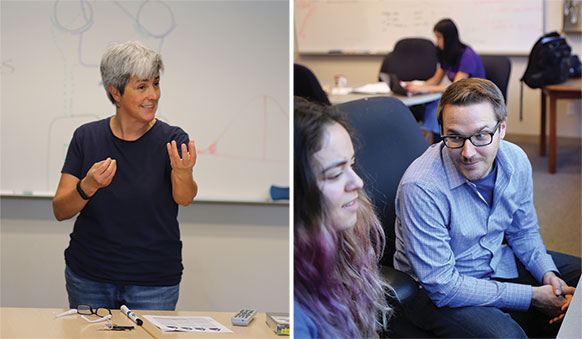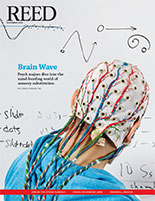
IRIS login | Reed College home Volume 93, No. 4: December 2014
Brain Wave (continued)

MIND-BENDERS. Prof. Canseco-Gonzalez (left) and Prof. Pitts (right) explain the how and why of neuroplasticity. Photos by Cate Whitcomb and Tom Humphrey.
Canseco-Gonzalez speaks in a warm voice with a Spanish accent. She grew up in Mexico City, earned a BA in psychology and an MA in psychobiology from the National Autonomous University of Mexico, and a PhD from Brandeis for her dissertation on lexical access. Fluent in English, Spanish, Portuguese, and Russian, she has authored a score of papers on cognitive neuroscience and is now focusing on neuroplasticity—the brain’s ability to rewire itself in response to a change in its occupant’s environment, behavior, or injury.
She also knows something about psychological resilience from personal experience. She was working in Mexico City as a grad student in 1985 when a magnitude 8.1 earthquake occurred off the coast of Michoacán, crumbling her apartment building and killing more than 600 of her neighbors. At least 10,000 people died in the disaster.
To demonstrate another example of sensory substitution, she gets up from her desk, stands behind me, and traces a pattern across my back with her finger. “Maybe you played this game as a child,” she says. “What letter am I writing?” Although I am reasonably well acquainted with the letters of the alphabet, it is surprisingly difficult to identify them as they are traced across my back. (I guess “R”—it was actually an “A.”)
Incredibly, this game formed the basis for a striking breakthrough in 1969, when neuroscientist Paul Bach-y-Rita utilized sensory substitution to help congenitally blind subjects detect letters. He used a stationary TV camera to transmit signals to a special chair with a matrix of four hundred vibrating plates that rested against the subject’s back. When the camera was pointed at an “X,” the system activated the plates in the shape of an “X.” Subjects learned to read the letter through the tactile sensation on their backs—essentially using the sense of touch as a substitute for the sense of vision.
Bach-y-Rita’s experiments—crude as they may seem today—paved the way for a host of new approaches to helping people overcome sensory deficits. But this line of research also poses fundamental questions about perception. Do the subjects simply feel the letters or do they actually “see” the letters?
This problem echoes a question posed by Irish philosopher William Molyneux to John Locke in 1688. Suppose a person blind from birth has the ability to distinguish a cube from a sphere by sense of touch. Suddenly and miraculously, she regains her sight. Would she be able to tell which was the cube and which the sphere simply by looking at them?
The philosophical stakes were high and the question provoked fierce debate. Locke and other empiricist philosophers argued that the senses of vision and feeling are independent, and that only through experience could a person learn to associate the “round” feel of a sphere with its “round” appearance. Rationalists, on the other hand, contended that there was a logical correspondence between the sphere’s essence and its appearance—and that a person who grasped its essence could identify it by reasoning and observation.
(Recent evidence suggests that Locke was right—about this, at least. In 2011, a study published in Nature Neuroscience reported that five congenitally blind individuals who had their sight surgically restored were not, in fact, able to match Lego shapes by sight immediately after their operation. After five days, however, their performance improved dramatically.)
On a practical level, sensory substitution raises fundamental questions about the way the brain works. Is it something that only people with sensory deficits can learn? What about adults? What about people with brain damage?
As faster computers made sensory-substitution technology increasingly accessible, Canseco-Gonzalez realized that she could explore these issues at Reed. “I thought to myself, these are good questions for Reed students,” she says. “This is a great way to study how the brain functions. We are rethinking how the brain is wired.”
She found an intellectual partner in Prof. Michael Pitts [psychology 2011–], who obtained a BA in psych from University of New Hampshire, an MS and a PhD from Colorado State, and worked as a postdoc in the neuroscience department at UC San Diego before coming to Reed. Together with Orestis, Chris, and Phoebe Bauer ’15, they bounced around ideas to investigate. The Reed students decided to tackle a deceptively simply question. Can ordinary people be taught how to do sensory substitution?
To answer this, they constructed a three-part experiment. In the first phase, they exposed subjects to the strange shapes and sounds and monitored their brainwaves. In the second phase, they taught subjects to associate particular shapes with particular sounds, and tested their subjects’ ability to match them up. They also tested subjects’ ability to match sounds they had never heard with shapes they had never seen. Finally, they repeated the first phase to see if the training had any effect on the subjects’ brainwaves.
“I was skeptical at first,” Prof. Pitts admits. “I didn’t really think it was going to work.”
The trials took place over the summers of 2013 and 2014, and the preliminary results are striking. After just two hours of training, subjects were able to match new sounds correctly as much as 80% of the time. “That’s a phenomenal finding,” says Pitts. What’s more, the Reed team found that the two-hour training had far-reaching effects. Subjects who were given the test a year later still retained some ability to match sounds to shapes.
Just as significant, the subjects’ brain-waves demonstrated a different pattern after the training, suggesting that the shape-processing part of the brain was being activated—even though the information they were processing came in through their headphones. “Here is the punch line,” says Canseco-Gonzalez. “There is a part of the brain that processes shapes. Usually this is in the form of vision or touch. But if you give it sound, it still can extract information.”
The results—which the Reed team hopes to publish next year—suggest that the brain’s perceptual circuits are wired not so much by sense as by task. Some tasks, such as the ability to recognize shapes, are so important to human survival that the brain can actually rewire itself so as to accomplish them.
Does this mean people can really hear shapes and see sounds, or does it mean that the difference between seeing and hearing is fuzzier than we like to think? Either way, the experiment suggests that the brain retains the astonishing property of neuroplasticity well into middle-age—and that we are only beginning to grasp its potential.
Editor's Note: This research was made possible by a grant from the M.J. Murdock Charitable Trust Research Program for Life Sciences and the Reed College Science Research Fellowship.
- Previous Page
- 1
- 2
- Next Page

LATEST COMMENTS
steve-jobs-1976 I knew Steve Jobs when he was on the second floor of Quincy. (Fall...
Utnapishtim - 2 weeks ago
Prof. Mason Drukman [political science 1964–70] This is gold, pure gold. God bless, Prof. Drukman.
puredog - 1 month ago
virginia-davis-1965 Such a good friend & compatriot in the day of Satyricon...
czarchasm - 4 months ago
John Peara Baba 1990 John died of a broken heart from losing his mom and then his...
kodachrome - 7 months ago
Carol Sawyer 1962 Who wrote this obit? I'm writing something about Carol Sawyer...
MsLaurie Pepper - 8 months ago
William W. Wissman MAT 1969 ...and THREE sisters. Sabra, the oldest, Mary, the middle, and...
riclf - 10 months ago